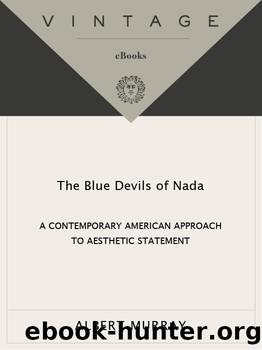The Blue Devils of Nada by Albert Murray

Author:Albert Murray [Murray, Albert]
Language: eng
Format: epub
ISBN: 978-0-307-82862-0
Publisher: Knopf Doubleday Publishing Group
Published: 2012-09-12T00:00:00+00:00
II
But obviously he did not learn to paint by listening to music. He learned to paint by looking at and responding to many paintings. Even when he listens to music on the radio while at work in his studio, his specific objectives and procedures are exclusively those of a painter, and accordingly his efforts are best understood and most fully appreciated in terms of and in the context of the works of the visual artists, not the musicians he admires and attempts to extend, elaborate, and otherwise refine, and those he rejects either in part or on the whole, and so ignores or feels compelled to counterstate.
Each painting, that is to say, is a visual statement that is a reference or allusion to another or other paintings, to which in effect it either says yes and also and also and perhaps also; or it says no or not necessarily or on the other hand or not as far as I for one am concerned. Not that musicians donât do exactly the same thing. Ellingtonâs unique voicings, for example, began by saying yes in some instances and no in others to King Oliver, Jelly Roll Morton, Fletcher Henderson, and even the likes of Paul Whiteman and the saw fiddle Tin Pan Alley extensions of George Gershwin. Such, after all, are the dynamics of the creative process. But the point is that as visual artists, painters must proceed in terms of existing visual statements. It is precisely thus that they participate in the ongoing dialogue that makes their métier what it continues to be.
Indeed, as should surprise no one, it was a painter who made Bearden realize, as only a painter could have, that elements of blues idiom musicianship could be applied to visual composition. During the days when he was still a young journeyman, so to speak, he used to visit the studio of Stuart Davis, an American master of post-Cubist persuasion, who had studied in Paris, and in the course of discussions about the approaches of Picasso, Matisse, Braque, and Juan Gris, among others, Davis, who had a large collection of jazz records, kept coming back to the music of Earl Hines and kept trying to make him see visual devices in terms of the way Hines did things on the piano. Davis, who was no less deeply involved with native U.S. techniques, raw materials, and attitudes than with avant-garde experimentation, also told him that the subject matter of painting includes the materials of expression.
But his friendship with Davis, who, by the way, was not native to the blues idiom, came not at the beginning of Beardenâs career as an artist, but (as stated above) a few years later. It was not what motivated him to become a painter. It was rather advice from an older and more accomplished fellow professional, and it gave him new insight into, and eventually a greater facility with, the ideas and techniques he had already acquired in the normal course of his apprenticeship to visual expression.
Download
This site does not store any files on its server. We only index and link to content provided by other sites. Please contact the content providers to delete copyright contents if any and email us, we'll remove relevant links or contents immediately.
The Goal (Off-Campus #4) by Elle Kennedy(13170)
Kathy Andrews Collection by Kathy Andrews(11280)
Diary of a Player by Brad Paisley(7236)
What Does This Button Do? by Bruce Dickinson(5917)
Assassin’s Fate by Robin Hobb(5822)
Big Little Lies by Liane Moriarty(5490)
Altered Sensations by David Pantalony(4834)
Pale Blue Dot by Carl Sagan(4580)
Sticky Fingers by Joe Hagan(3888)
The Death of the Heart by Elizabeth Bowen(3314)
The Heroin Diaries by Nikki Sixx(3294)
Beneath These Shadows by Meghan March(3123)
Confessions of a Video Vixen by Karrine Steffans(3084)
The Help by Kathryn Stockett(2997)
How Music Works by David Byrne(2933)
Jam by Jam (epub)(2862)
Harry Potter 4 - Harry Potter and The Goblet of Fire by J.K.Rowling(2778)
Strange Fascination: David Bowie: The Definitive Story by David Buckley(2688)
Petty: The Biography by Warren Zanes(2558)
